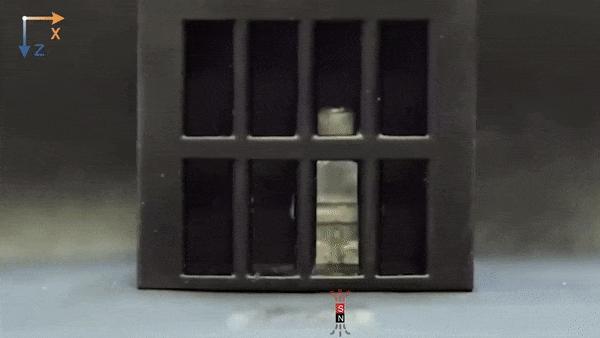This Shape-Shifting Robot Can Liquefy Itself and Reform
The technology could one day assemble and repair hard-to-reach circuits, act as a universal screw or retrieve foreign objects from a body, researchers say

Researchers have created a miniature robot that can melt and reform back into its original shape, allowing it to complete tasks in tight spaces or even escape from behind bars. The team tested its mobility and shape-morphing abilities and published their results Wednesday in the journal Matter.
While a melting, shape-shifting robot sounds like something out of a sci-fi movie, the team actually found their inspiration in a marine animal here on Earth: a sea cucumber. Sea cucumbers “can very rapidly and reversibly change their stiffness,” senior author and mechanical engineer Carmel Majidi of Carnegie Mellon University tells Science News’ McKenzie Prillaman. “The challenge for us as engineers is to mimic that in the soft materials systems.”
Traditional robots are stiff and hard-bodied, so they can’t always maneuver through small spaces. Soft robots, on the other hand, are more flexible, but they tend to be weaker and harder to control. So, to create a material both strong and flexible, the team created one that could shift between liquid and solid states.
To achieve this feat, the researchers made their robot out of a metal called gallium—which has a low melting point of about 86 degrees Fahrenheit—and embedded magnetic particles within it. Because of these particles, scientists can control the robots with magnets, prompting them to move, melt or stretch.
The magnetic particles also make the robots respond to an alternating magnetic field, or one that changes over time. This produces electricity inside the metal, raising its temperature. Using this magnetic field, “you can, through induction, heat up the material and cause the phase change,” Majidi says in a statement. Then, ambient cooling causes the material to solidify again. The research team calls their invention a “magnetoactive solid-liquid phase transitional machine.”
In a series of tests, the new robot could jump up to 20 times its body length, climb walls, solder a circuit board and escape from a mock prison. It could support an object about 30 times its own weight in its solid state, per the study.
Researchers say this technology might have applications in the biomedical field. To show how, they used the robot to remove a ball from a model human stomach. The solid robot was able to move quickly to the ball, melt down, surround the ball, coalesce back into a solid and travel with the object out of the model. In this test, the researchers used gallium, but a real a human stomach has a temperature of about 100 degrees Fahrenheit—higher than the metal’s melting point. The authors write that more metals could be added to the material to raise its melting point.

“It’s a compelling tool,” Nicholas Bira, a robotics engineer at Harvard University who was not involved in the study, tells Science News. But while soft robotics researchers are often creating new substances, “the true innovation to come lies in combining these different innovative materials,” he tells the publication.
In the future, the gallium robots could help assemble and repair hard-to-reach circuits or act as a universal screw by melting and reforming into a screw socket, the team says. Before the robot can be used in a living person, though, scientists must figure out how to track its position within a patient, Li Zhang, a mechanical engineer at the Chinese University of Hong Kong who was not involved in the study, tells New Scientist’s Karmela Padavic-Callaghan.
“Future work should further explore how these robots could be used within a biomedical context,” Majidi says in the statement. “What we’re showing are just one-off demonstrations, proofs of concept, but much more study will be required to delve into how this could actually be used for drug delivery or for removing foreign objects.”
/https://tf-cmsv2-smithsonianmag-media.s3.amazonaws.com/accounts/headshot/MargaretOsborne.png)
/https://tf-cmsv2-smithsonianmag-media.s3.amazonaws.com/accounts/headshot/MargaretOsborne.png)